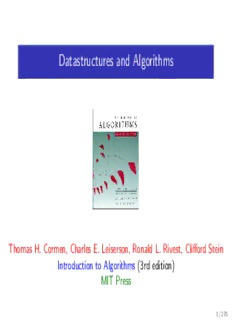
Datastructures and Algorithms PDF
Preview Datastructures and Algorithms
Datastructures and Algorithms Thomas H. Cormen, Charles E. Leiserson, Ronald L. Rivest, Clifford Stein Introduction to Algorithms (3rd edition) MIT Press 1/287 Red thread (Dutch expression) of this course Programming requires algorithmic design. Computers are founded on a universal computation framework. We will study basic data structures and algorithms. Some (at first sight simple) problems are undecidable. Some finite, NP-complete problems, like the traveling salesman problem, can probably not be solved efficiently on a computer (if P(cid:54)=NP). 2/287 What this course is (not) about This isn’t a programming course (there are no computer labs). It isn’t a theory course either (proofs are omitted or sketched). Still, this course is crucial to become a good programmer (algorithms, data structures). We will delve into the foundations of computer science (undecidability, P=NP). And we will look at another model of computation (quantum computing). 3/287 Example algorithm: baking a cake ingredients input recipe algorithm (software, computer program) tools data structures oven hardware cake output 4/287 Example: Euclid’s greatest common divisor algorithm Euclid (Alexandria, around 300 BC) Compute the greatest common divisor of two non-negative numbers n ≥ m: (cid:73) if m = 0, then return n; (cid:73) else, compute the greatest common divisor of m and n mod m (i.e., the remainder after dividing n by m). The second line contains a recursive call. 5/287 Pseudocode of Euclid’s algorithm Compute greatest common divisor of natural numbers m and n Euclid(m : natural,n : natural) if m = 0 then return n if n = 0 then return m if m < n then Euclid(m,n mod m) else Euclid(m mod n,n) 6/287 Algorithm An algorithm is a list of instructions that captures the essence of (part of) a computer program. Important aspects: (cid:73) Termination: does the algorithm always produce output? (cid:73) Correctness: does it meet its requirements? (cid:73) Efficiency: how much time and memory space does it use? 7/287 Data structure A data structure is a particular way of storing and organizing data in a computer so that it can be used efficiently. Different data structures are suited to different applications; some are highly specialized to specific tasks. An abstract data type specifies a data structure by operations performed on it, including exception handling: anomalous/exceptional events requiring special processing. Example: A stack is defined by two operations: (cid:73) push(d) inserts datum d on top of the stack. (cid:73) pop() extracts the top item from the stack, if it is non-empty. 8/287 Our model Computer: Random Access Machine (RAM) Algorithm: description in pseudocode Data structure: specification as an abstract data type 9/287 Random Access Machine (RAM) Central Processing Unit (CPU) with memory: CPU Memory Assumptions: (cid:73) Unlimited number of memory cells, also called registers. (cid:73) Primitive operations, like reading or writing to a register, take constant (little) time. 10/287
Description: